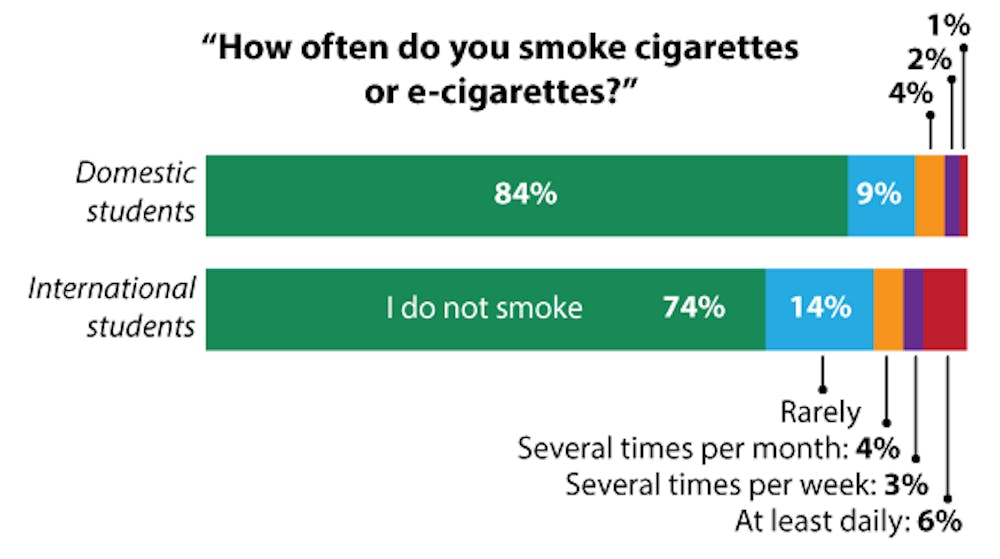About 17 percent of undergraduate students smoke cigarettes or e-cigarettes, according to a Herald poll conducted Oct. 28-29. The poll found that 9.7 percent of students smoke rarely, 3.7 percent smoke several times per month, 2.1 percent smoke several times per week and 1.9 percent smoke at least daily.
Brown’s overall smoking rate is not surprising, said Rachel Cassidy, assistant professor of behavioral and social sciences. “Unfortunately, I think that’s within the realm of what’s reported,” she said.
Among adults in the United States ages 18 to 25, 28.4 percent have smoked cigarettes in the past month, and 37.7 percent have smoked in the past year, according to a 2014 survey from the National Institute on Drug Abuse. Statistics were not available for the college student population.
“There’s a bit of an inverse socioeconomic relationship — believe it or not, poor people are more likely to smoke,” said Robert Swift, professor of psychiatry and human behavior, adding that the University’s rate made sense considering its somewhat elevated socioeconomic status.
The Herald’s poll also found that male students were more likely to smoke than female students: About 21 percent of male respondents indicated they smoked, compared to about 14 percent of female respondents.
Older students were also more likely to smoke. The poll found that 3.7 percent of seniors smoke daily, compared to 0.7 percent of first-years, 1.5 percent of sophomores and 2.2 percent of juniors. Overall, 22 percent of seniors indicated they smoked, while only about 14 percent of first-years indicated that they did.
International perspective
International students were more likely to be smokers than domestic students in all of the polling categories, and the most significant difference was among heavy smokers. While only 1.1 percent of domestic students smoke daily, 5.8 percent of international students smoke ar that rate, according to the poll.
These students probably hail from places where smoking is more common and more socially accepted, said Jennifer Tidey, associate research professor of psychiatry and human behavior and of behavioral and social sciences.
“In the United States, very few medical professionals smoke,” Swift said. But when visiting a hospital in Rome, Swift found smoking to be so common that the doctors had their own smoking lounge.
Hannah Baackmann-Friedlaender ’19 started smoking about a year ago while she was living in Bosnia and Herzegovina. “Taking a cigarette break, taking a moment, was very much part of the culture and the way of life, and that’s kind of what drew me to it,” she said. “The best part about smoking is the community. It’s the perfect length of time to have a miniature conversation, to get to know some random person. That’s the biggest reason I started smoking.”
But in the United States, Baackmann-Friedlaender has met few other smokers. Last year while in Bosnia and Herzegovenia, she would smoke 20 to 30 cigarettes per day when she was stressed and 10 to 15 on a normal day. At Brown, she smokes about seven cigarettes a day. She plans on trying to quit smoking over winter break.
On campus, smoking is not allowed indoors or within 35 feet of the entrance to any campus building, according to the Facilities Management website.
Angelica Cotto ’19 said she thinks these limitations are in place “to make sure you’re being conscious of other people.”
“It’s enforcing a proper smoking etiquette, so I’m behind it,” Cotto said.
“The U.S. culture of shunning cigarettes makes you more aware of what it’s doing to you,” Baackmann-Friedlaender said.
A safer alternative?
“Rates of college students smoking have not gone down as much as we would have liked them to, and there’s been some evidence that they may be increasing,” Cassidy said, adding that there has been a rise in intermittent smoking.
Cotto said she has experienced no negative health effects from smoking, which she began over the summer with friends. She plans to continue smoking about once or twice a month, and she would try to quit if she ever began smoking more frequently.
Cotto considers herself addicted but in control of her smoking. “I’m powerful and I don’t give into it, because I do get really intense cravings,” she said.
But Cassidy cautioned that even occasional smoking leads to health risks. “Every single cigarette can increase your risk of lung cancer,” she said. “We’re concerned that we see this disconnect between behavior and people’s perception of their risk for smoking.”
Recently, the use of electronic cigarettes by college students has risen, Cassidy said. E-cigarettes are a safer alternative to regular cigarettes, but their health effects are still not fully understood, she said. The Herald poll did not differentiate between cigarette and e-cigarette use.
The goal of e-cigarettes “is to deliver nicotine without delivering the smoke, which contains carcinogens and carbon-monoxide and harmful things,” Swift said. “But I think there’s concerns about that as well.”
Some cigarette smokers may switch from cigarettes to e-cigarettes, which Cassidy said is a positive change because of the lower health risks. “That doesn’t mean they’re safe, period, but they’re certainly safer than cigarettes.”
“Whether e-cigarettes increase regular cigarette use is a big concern,” Tidey said, adding that the products are too new for scientists to have measured the long-term effects.
Problems solved, problems created
“Nicotine’s an interesting drug,” Swift said, noting that it has a stimulant effect and is cognitive-enhancing.
Baackmann-Friedlander has found that smoking helps her think when doing computer science homework. “Whenever I go out and smoke a cigarette and step back, it’s so much easier to solve the problem afterwards. But it’s more a psychological thing,” she said, adding that cigarettes also make her feel “fuzzy-headed.”
Cigarettes have affected Baackmann-Friedlaender’s health as well. “I’ll cough in class and it sounds like I’m some dying old woman,” she said.
“I don’t know if I wish I hadn’t started completely,” she added. “In a lot of respects I do, just because it’s really annoying to be physically addicted to something that’s so damaging.”

ADVERTISEMENT




